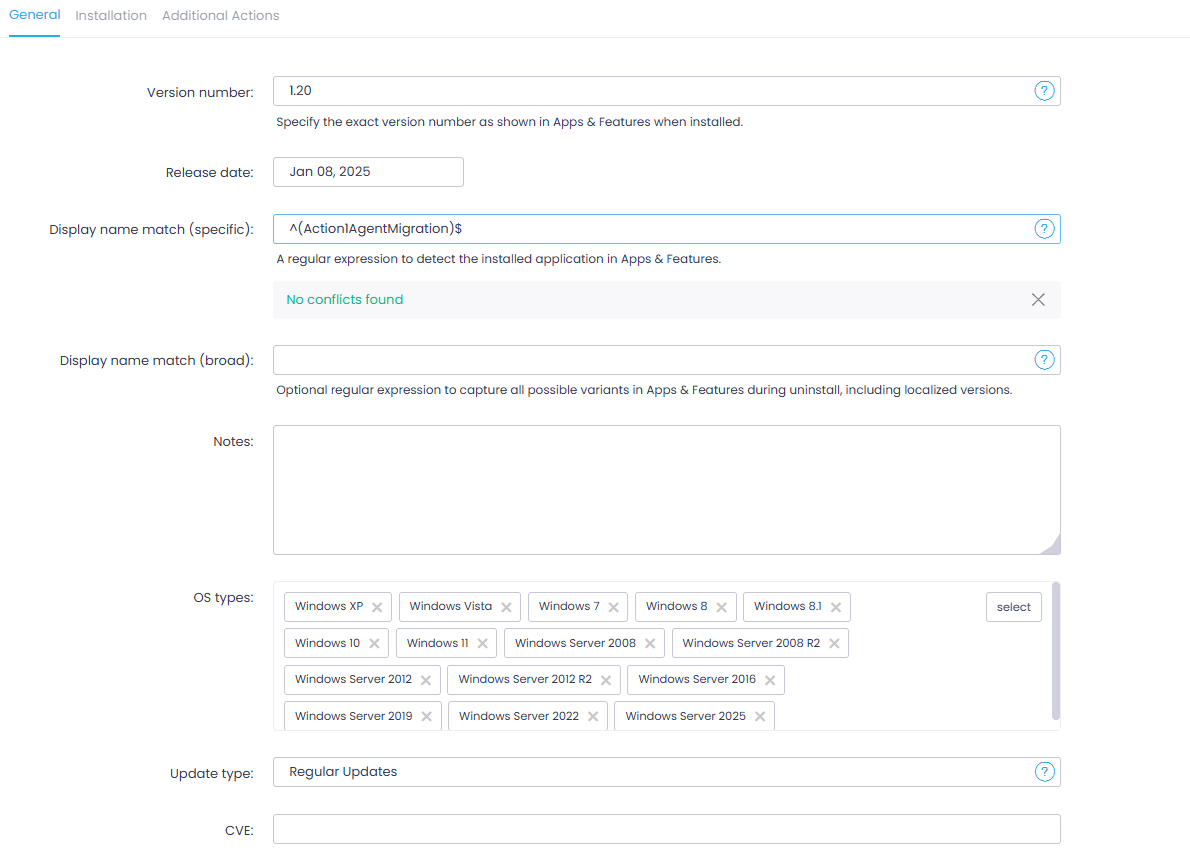Migrating Between Regions
To support data protection laws and compliance standards enforced in your country, Action1 enables customers to choose where to store the endpoints and associated data. Currently, Action1 data centers are located in the following regions:
- North America
- Europe
- Australia
To ensure data integrity and compliance, consider moving your account and endpoints to a relevant region. This article explains how to migrate your account and endpoints manually, and provides step-by-step instructions. Automated migration will be available later.
NOTE: Groups, user accounts, automations, custom applications, scripts, data sources, and reports cannot be transferred and should be moved manually.
The procedure steps are as follows:
- Create a new Action1 account.
- Prepare endpoints for migration.
- Create new Action1 organizations.
- Create a migration app package.
- Upload the migration app package to the Software Repository.
- Perform a test migration manually.
- Deploy the migration app package to the target endpoints using Deploy Software automation. Wait for the automation to complete the migration app execution on target endpoints.
- Finalize your migration.
Step 1: Create a New Action1 Account
Start by registering a new Action1 account with the same email address, make sure to specify a different region, e.g., Europe.
- Free subscription: complete verification of a new account
- Paid subscription: contact support to transfer your license to a new region. As soon as the license is transferred to the new account, the subscription of the initial account will expire in a month.
Step 2: Prepare Endpoints for Migration
Before you start migrating endpoints, complete the following tasks in your initial account. For each organization:
- Sign in to the initial account.
- Make sure endpoints are online.
- If you are using Action1 Deployer, disable it. For that, on the endpoint where Action1 Deployer is installed, open the Services snap-in and stop and disable the appropriate service. Then, in the Action1 console, navigate to Configuration > Agent Deployment and ensure Deployer doesn’t manage your endpoints.
- Disable all automations.
- Make sure there are no automations running against the endpoints.
Step 3: Create New Organizations
In your new account:
- Re-create the organizations you had in your initial account.
- For each organization, download the Action1 agent.
Step 4: Create the Agent Migration Package
NOTE: Below are the steps for migrating a single organization. Multiple organizations should be migrated one by one, following the same steps for each organization.
In your initial account, you need to create a software package that includes the migration_v1.20.zip file. This package will be used to update the endpoints from the respective initial organization and move them to the organization in your new account.
For an organization, create the zip archive:
- Download migration_v1.20.zip
- Add the agent installer (MSI file) from the respective new organization to this ZIP archive.
As a result, the ZIP archive should include the following files:
- action1_agent(My_Organization).msi
- launcher.ps1
- migration.ps1
Step 5: Create Apps for Migration
In your initial account, upload the migration_v1.20.zip package you prepared to the Action1 Software Repository. Then you’ll be able to deploy it to the target endpoints using automation.
- Navigate to Software Repository and select + Add to Repository.
- In the Name field, enter
Agent_Migration, in the Vendor field, enterAction1and specify Description. Select Windows from the list of platforms. - Save the settings.
- Then click Add Version.
- On the General tab, make sure that:
- Version number is set to 1.20
- Display name match (specific) is set to ^(Action1AgentMigration)$
- Save the settings.
- On the Installation tab:
- Go to x86 installation file and click “…“.
- In the dialog that opens, select Private P2P distribution via Action1 Cloud option and upload the .zip file you prepared.
- Click Confirm to apply the changes and close the dialog.
- Back on the Installation tab, make sure the value for Silent install switches is set to launcher.ps1
Step 6: Test Deployment
In your initial account, test a single endpoint migration. For that:
- Navigate to the Endpoints view.
- Select an endpoint and install the Agent_Migration software package on it using Deploy Software.
- Wait for the automation to complete. Make sure it completes without errors.
- Navigate to your new account and verify that the endpoint was added to a proper organization.
Step 7: Move Endpoints
In your initial account, create a Deploy Software automation for the organization. This automation should install the migration software package (Agent_Migration) to all endpoints within the organization. See also: Deploy Software
Step 8: Close the Initial Account
Once all your endpoints are up and running in their respective organizations within a new account, you can close your original tenant.
- Free subscription: in Action1 console, navigate to Subscription and select Close Account.
- Paid subscription: contact your account manager. The account manager will reach out to the support team, who will advise you on the steps needed to finalize the migration.
NOTE: The subscription associated with the old account will stay valid for 30 days, then it will be removed automatically.
TIP: To maintain multi-region topology, you can keep both accounts. Paid customers are advised to contact their Sales representative for an updated quote.


